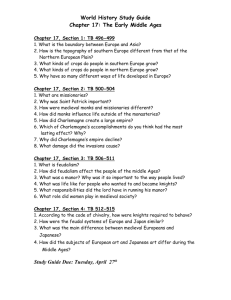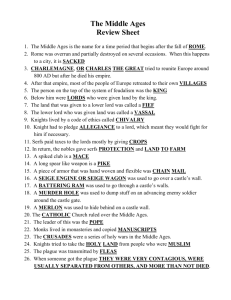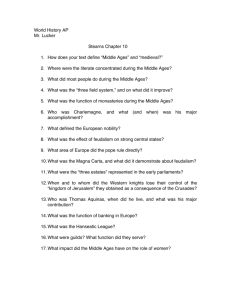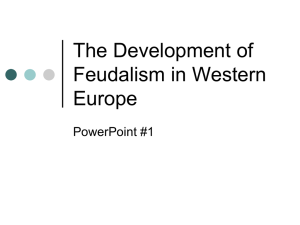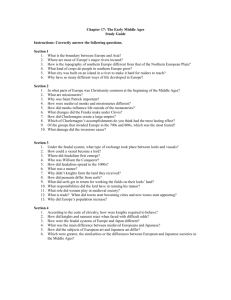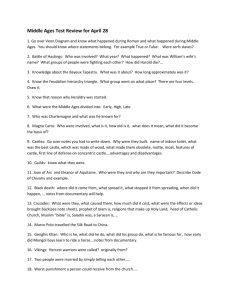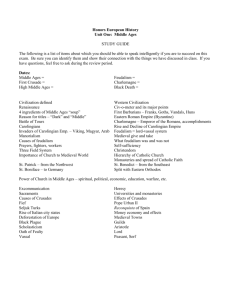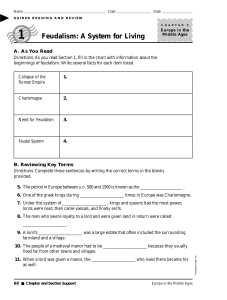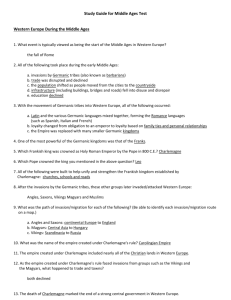14.1 Becknell - Pennsbury School District
advertisement
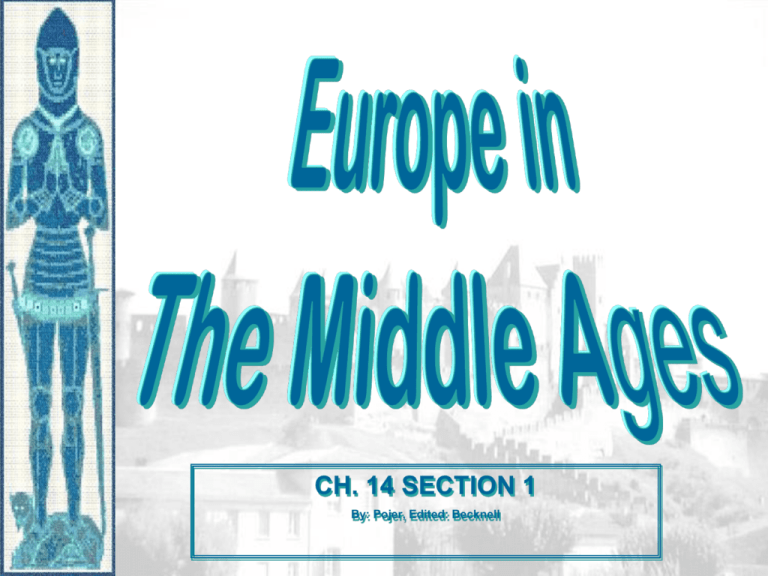
CH. 14 SECTION 1 By: Pojer, Edited: Becknell Tues 12/18/12 • Fill in p. 2 of your new packet, “BEFORE” by making predictions- we’ll return to this in a later lesson! Clean out binders of ch. 10 materials • Pick a MEDIEVAL TITLE & NAME! • Partner activity- analyze images and make predictions about Charlemagne and how he affected Western Europe • HW- Illustrate facts about Charlemagne’s background and accomplishments in your notes (use p. 3 of new packet) Periodization Early Middle Ages: 500 – 1000 High Middle Ages: 1000 – 1250 Late Middle Ages: 1250 - 1500 Predict… • Analyze the next several images and make predictions. • What do you see? Create a caption for each image. • What do you think happened in Western Europe, based on the images? Write a sentence to explain your prediction. Europe in the 6th century (501-600) Charlemagne: 742 to 814, King of the Franks Pope Crowned Charlemagne Holy Roman Emperor: Dec. 25, 800 Charlemagne • King of the Franks • Reunited small kingdoms into one • Expanded his kingdom & ruled over most of Western Europe for 50 years (The Holy Roman Empire) • Promoted learning and culture by establishing schools • Spread Christianity • Issued money & improved the economy Charlemagne died: His empire was divided among his three sons who fought one another. Vikings also attacked, burning and looting European towns. Charlemagne’s empire was gone. DURING THE MIDDLE AGES… • Attacks by Vikings were a constant threat. • Life was dangerous. • So, society attempted to protect itself… Feudalism ROLE PLAY A political, economic, and social system based on loyalty and military service. Feudalism A political, economic, and social system based on loyalty and military service. Thursday 12/20/12 • Review Social Structure in the Middle Ages & Vikings Homework • Role play FEUDALISM • If time remains, read 14.1 to find out more about Feudalism & the Middle Ages • • • • • • Vikings (p. 7) 1. When Charlemagne died 2. The Scandinavian peninsula (Sweden, Norway, & Denmark) 3. “Beserkers,” warriors who prepared for battle by eating wild plants that drugged them & made them crazy 4. Odin (god of battle & death) & Thor (god of storms & winds) 5. Polytheistic 6. Iceland & Greenland (they needed to sail the Atlantic to get to them) Vikings (p. 7) • 7. Normandy is on the (west) coast of France • 8. William the Conqueror was the leader of the Danish Vikings who attacked & defeated England (in 1066- Battle of Hastings!) • 9. In the Baltic area (by the Baltic sea) • 10. Why?/ Why not? Social Structure in the Middle Ages: A Video • • • • • • 1. William the Conqueror 2. His vassals 3. Homage 4. True! A vassal is any loyal subject 5. A Feudal relationship 6. If her husband died or if she were a daughter with no brothers (for a while) • 7. False – they married for land Social Structure in the Middle Ages: A Video • 8. Nuns • 9. To have children & raise them (also looked over land & servants) • 10. Wives of merchants • 11. William Marshal • 12. True • 13. To the manor! (the land) • 14. Serfs still got a place to live, food, and protection • 15. The Church! (The Roman Catholic Christian Church) Feudal Role Play • • • • • Monarch (King) FOUR Lords/Ladies Lords/Ladies must pledge LOYALTY to King Each Lord/Lady picks 2 Knights Knights must pledge LOYALTY to Lord/Lady and be KNIGHTED • Each Lord/Lady picks 1 regular peasant and 2 SERFS • Serfs must be “Tied to” manor • Peasants (including serfs) need to pay taxes to their lords in the form of “Crops” and follow the laws of their lords. Feudalism A political, economic, and social system based on loyalty and military service. Oath of Fealty • Knight: (on bended knee) I pledge to honor and protect you and your fief. I pledge my unwavering loyalty to your laws and those of our King. • Lord: I hereby dub thee “Knight.” Go forth as my vassal. (Use the “sword” to touch each of the knight’s shoulders) Thursday 1/3/13 • Review notes for 14.1 – p. 4/5 of your packet • “Parts of a Castle”- partner activity! Meet with your 12:00 partner. Read over the parts of a castle, p. 9 of the packet, and label the castle diagram appropriately; Raise your hand when you think you’ve got them right! • Start HW- Medieval Castle crossword Ch. 14 Sect. 1 • Last night, you should have read p. 394-399 in the text • As we go over the note sheets on p. 4/5 of your packet, check your answers! When were the Middle Ages? They were between ancient and modern times! (The years 500-1500 AD) Early Middle Ages: 500 – 1000 High Middle Ages: 1000 – 1250 Late Middle Ages: 1250 - 1500 Knights • Professional horse soldiers who led other men into battle • Sometimes held land • Had to go through three stages of training • pledged loyalty to lord/king The Road to Knighthood KNIGHT (age 18) SQUIRE (age 13) PAGE (age 7) Charlemagne • King of the Franks • Reunited small kingdoms into one • Expanded his kingdom & ruled over most of Western Europe for 50 years (The Holy Roman Empire) • Promoted learning and culture by establishing schools • Spread Christianity • Issued money & improved the economy Vikings • A tribe of “Northmen” From Scandinavia (Norway, Sweden, Denmark) who explored and attacked the rest of Europe during the Middle Ages Why did Charlemagne’s empire fall apart? When Charlemagne died, his empire was divided among his three sons who fought one another. Vikings also attacked. Feudalism A political, economic, and social system based on loyalty and military service. Fiefs & Vassals • Monarchs (Kings) controlled the land • They gave FIEFS (shares of land) to their VASSALS . • Vassals were people who were loyal to those above them. • Monarchs collected taxes from their vassals. What did the lords give in exchange for the vassals loyalty? • Lords made sure that their vassals were protected and provided for A Medieval Manor A large estate that included farm fields, pastures, and often an entire village Lord of the manor • Noblemen JOBS: • Raised and led armies • Collected taxes • Ruled over the manor by making rules and acting as judges Noblewomen • Also called “Ladies” of the household • Jobs: Managed the home, performed medical tasks, and supervised servants • Made decisions for manor when her husband was away at war Why did MANORS have to be self-sufficient? Manors HAD to be selfsufficient because they were far away from other villages and manors. Also, they were often under attack; safety was a big concern and staying put (by the fortress) was the best way to stay safe Peasants & Serfs Peasants : • Farmers and laborers • Farmed for their lords (only farmed a small strip for themselves) Most peasants were Serfs: • considered part of the manor. • They could not leave or marry without permission of the lord • COULD buy their freedom What was life like for medieval peasants? • Life was full of hard work! MotteUp to 100 ft high! The Keepfortified house BaileyWalled area where soldiers & peasants lived Motte & Bailey Castle, Early Middle Ages Carcassonne CastleHIGH Middle Ages , 1000- 1300 AD Made of Stone- Needed to withstand evolving technologies, like flame-throwers and cannons! Friday 1/4/13 • Review homework & “parts of a castle” diagram • Choose Your Own Adventure: -Life in an English Castle! After each step, remember to SUMMARIZE what happened & return the sheet to the proper folder! - Did you make the right decisions? Medieval Castle Across Down • • • • • • • • • • • • • • • • • • • • • • • • • • • • 1. Barracks 6. Pitch 8. Catapult 11. Moat 12. Private Chambers 13. Dragon 15. Stocks 16. Main Hall 19. Peasant 21. Keep 22. Church 24. Maiden 26. Parapet 27. Prison 28. Knight 2. Kitchen 3. Drawbridge 4. Gatehouse 5. Troubadour 7. Herald 9. Arrow Loops 10. Wall Tower 14. Barbican 17. Wall Walk 18. Jester 20. Turret 23. Ward 25. Joust • Choose Your Own Adventure: -Life in an English Castle! Read the first page together After each step, remember to SUMMARIZE what happened & return the sheet to the proper folder! - Did you make the right decisions? - If time remains, complete “p. 8”- the backside of page 1. Do all T/F questions & pick one short answer Monday 1/7/13 • Distribute Field Trip info & permission slips! Trip is March 4th! Cost is $30.00 Money & Slips are due Tues, 1/22! • Go over “Life in an English Castle,” adventure & turn in the question sheet • Return to p. 2 of the packet- go over the T/F questions on ch.14.1 • 14.2: Brainstorm- what are the most important buildings in your neighborhood/community? Write them on the white boards • Find out more about CHRISTIANITY The Middle Ages: Fact or Fiction? • • • • • • • 1. T 2. T 3. F 4. T 5. T 6. T 7. F • • • • • • • 8. T 9. F 10. T 11. F 12. F 13. F 14. T
